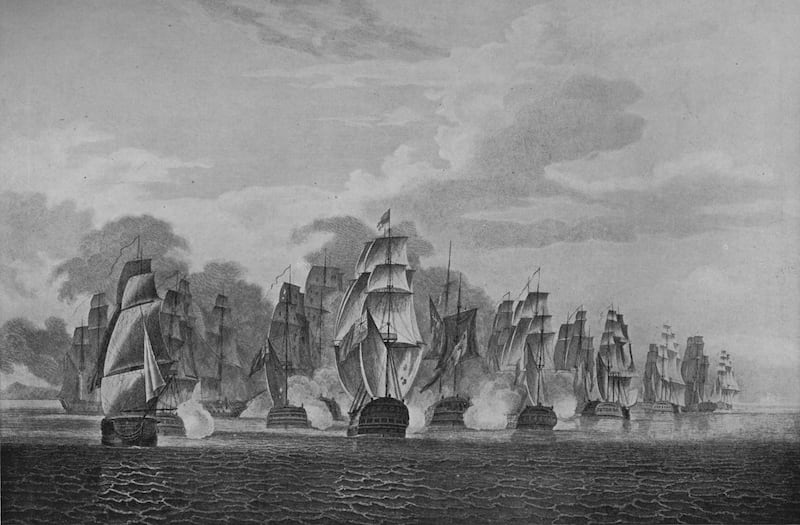Ever since November 1798, Wolfe Tone, the founding father of Irish republicanism, has been deliberately smeared. According to his jailers, he attempted suicide the night before he was to be hanged, botched the job and lasted an agonising eight days before succumbing to his injuries. This smear passed into official history almost immediately – and with little further interrogation has been accepted by the Irish historical establishment to this day.
In this 225th anniversary year of the rebellion, which began on May 24th, 1798, I believe another scenario is infinitely more believable: Tone was murdered by a cabal of Dublin military and law enforcement who connived to ensure he would not survive.
Theobald Wolfe Tone was born in Dublin in 1763 and grew up a middle-class Protestant in the era of the Protestant ascendancy and of the Penal Laws imposed on both Catholics and Dissenters, or Presbyterians. Combining the Enlightenment ideas of Tom Paine and the seismic events of the American and French Revolutions, Tone courted disaster with his radical idea of uniting Protestant, Catholic and Dissenter to free Ireland from oppressive British rule.
[ A Meeting with Matilda ToneOpens in new window ]
Tone left Ireland for the United States in 1795, after documents were discovered declaring the United Irishmen – 250,000 of them – ready for revolution. The organisation was banned, Tone went to France, and 1797 became a year of terror in Ireland, initiated by a brutal Dublin parliament after Tone convinced the French Directory to send a fleet of ships and 15,000 troops to Bantry Bay in December 1796.
READ MORE
The mission was unsuccessful, yet he organised three more missions through the rebellion of 1798. In August that year 1,000 French troops landed in Co Mayo under Gen Jean-Joseph Humbert, rekindling a rebellion thought quashed in July. Though defeated two weeks later, this Hiberno-French force scored four significant victories, an indication of what might have been had Napoleon listened to Tone and concentrated his energies on Ireland.
Tone sailed with a final mission of 3,000 soldiers but was intercepted at the Battle of Tory Island that October. Though dismissed as a “constitution-monger”, he fought with “the utmost coolness and bravery”, commanding a battery of cannon, before being captured and brought to Dublin in chains. Illegally court-martialled, Tone was sentenced to death by hanging at 1pm on Monday, November 12th, 1798.

His legal team, led by John Philpot Curran, fought from 11am that day to have him released to civil court. Chief Justice Kilwarden agreed. A writ of habeas corpus was issued but refused by Tone’s jailer, Maj William Sandys. A second writ was issued – only on this occasion it was revealed that Tone had “attempted suicide”, using a razor blade on his windpipe, at 4am the night before. For the next eight days Tone received no visitors while newspapers drip-fed the words of the prison’s surgeon to posterity.
That surgeon, Benjamin Lentaigne, a French physician who served in the British army, was instrumental in selling Sandys’s suicide myth with poetic “last words” from Tone that sound more Shakespearean than Tone’s usual syntax. “I find, then, I am but a bad anatomist,” rings hollow, especially as the wound was judged at the coroner’s inquest as only a quarter inch, or barely more than 5mm, wide, far from being fatal, which implies that an excellent anatomist had been responsible for it.
We were also treated to the impossible yarn of Tone finding his brother’s razor in the cell and using it on himself, as if Mathew Tone, executed six weeks earlier, had predicted Tone’s imprisonment and left the blade there for him. This razor – or “penknife”, as some accounts report – has never appeared, despite Sandys and his fellow majors Henry Sirr and William Swann being avid hoarders of 1798 memorabilia. Tone’s death mask was sold in 1899 by a descendant of Sandys, yet the blade has never shown up at auction.
The man whose co-ordination of four seaborne French invasions of Ireland – judged by his fellow Irishman the duke of Wellington to be an “achievement of genius” – could not escape
I believe Tone was murdered in the time between the issuing of the two writs of habeas corpus, then allowed to “die” over the next eight days to facilitate the story. What motivation would Sandys and Lentaigne have for murdering him? Both men had lost to revolution: Lentaigne’s two brothers went to the guillotine; Sandys’s brother Simon died at Vinegar Hill during the Wexford rebellion. A higher power guided their actions: the hard men of Dublin’s military and law enforcement knew there was a real chance Tone could be spared by civil court, especially as Lord Kilwarden was a friend to the Tone family (and even rumoured to be Tone’s real father).
In Paris, Gen Charles Jennings, the Irish soldier in French service also known as Brave Kilmaine, was fully prepared to swap a British officer of equal rank for Tone. But he could not be allowed to live. The man whose co-ordination of four seaborne French invasions of Ireland – judged by his fellow Irishman the duke of Wellington to be an “achievement of genius” – could not escape.
Tone’s biographer Marianne Elliott called his suicide a “godsend” – the Catholic Church railed against the “cut-throat Tone” for two centuries, besmirching the Catholic-rights activist as a morally repugnant coward. Irish historians bought it, quoting fake or nonexistent letters that the government-controlled press deemed authentic. They ignored Tone’s son William, who questioned the manner of his father’s death in his epic contribution to Life of Theobald Wolfe Tone, the collection of Tone’s writing that his widow and William compiled after his death.
Tone could have slit his wrists in “the old Roman way” – not his throat, which is an action more likely done by one human being to another
The historian and politician Frank MacDermot called Tone’s suicide “as sure as anything in history” – a bizarre assertion refuted by the brilliant C Desmond Greaves in 1963.
The same historians who sold the 1798 rebellion as a vicious campaign of massacres on “both sides” also attempted to absolve Sandys of his terrible reputation as a torturer and bribe merchant. The facts are stark: about 200 loyalists were killed in cold blood; 100 times as many rebels – 20,000 – were slaughtered after laying down their arms. And Sandys was no saint. The only academic treatment of Tone’s death, which appeared in History Ireland, depends, I believe, on a misreading of Sandys’s motivation in wanting Tone to get a stake through the heart to bolster the suicide myth.
Another misunderstanding looms large in the suicide camp: Tone’s admiration for Seneca and Cato and desire to die in the “old Roman way”. Tone could have slit his wrists in “the old Roman way” – not his throat, which is an action more likely done by one human being to another.
[ Surgeon's report reopens debate on ToneOpens in new window ]
As for Sandys, the man I believe to be the murderer of Wolfe Tone, he died a penniless alcoholic in 1812. A few months later, in a pamphlet published in Latin, Lentaigne wrote Testamen de Causis Morborum, or Testimony of the Causes of Diseases; discovered only in 1973, and not translated until some time later, it referred to a prisoner who had a “bullet through the throat that lodged in the lung”. Was a guilt-ridden surgeon revealing a truth just before his own death, in 1813?
As with Michael Collins, we owe Wolfe Tone and the manner of his death a fresh appraisal. Simple acceptance of “winner’s history” is no longer an option. Nor can we accept “loser’s history”, that well-meaning but foolish inclination to believe the official story, because it gives Tone agency and a fearless choice in his fate. The facts and common sense should dictate the way we view the circumstances of that dreadful week in Provost Prison. It’s the very least our greatest and most eloquent patriot deserves.
Paddy Cullivan is the creator and performer of The Murder of Wolfe Tone and of The Murder of Michael Collins; both productions are touring Ireland this summer, including at Dalkey Book Festival on Thursday, June 15th, and Sunday, June 18th


















